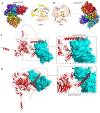Protein structural insights into a rare PCSK9 gain-of-function variant (R496W) causing familial hypercholesterolemia in a Saudi family: whole exome sequencing and computational analysis
- PMID: 37469559
- PMCID: PMC10353052
- DOI: 10.3389/fphys.2023.1204018
Protein structural insights into a rare PCSK9 gain-of-function variant (R496W) causing familial hypercholesterolemia in a Saudi family: whole exome sequencing and computational analysis
Abstract
Familial hypercholesterolemia (FH) is a globally underdiagnosed genetic condition associated with premature cardiovascular death. The genetic etiology data on Arab FH patients is scarce. Therefore, this study aimed to identify the genetic basis of FH in a Saudi family using whole exome sequencing (WES) and multidimensional bioinformatic analysis. Our WES findings revealed a rare heterozygous gain-of-function variant (R496W) in the exon 9 of the PCSK9 gene as a causal factor for FH in this family. This variant was absent in healthy relatives of the proband and 200 healthy normolipidemic controls from Saudi Arabia. Furthermore, this variant has not been previously reported in various regional and global population genomic variant databases. Interestingly, this variant is classified as "likely pathogenic" (PP5) based on the variant interpretation guidelines of the American College of Medical Genetics (ACMG). Computational functional characterization suggested that this variant could destabilize the native PCSK9 protein and alter its secondary and tertiary structural features. In addition, this variant was predicted to negatively influence its ligand-binding ability with LDLR and Alirocumab antibody molecules. This rare PCSK9 (R496W) variant is likely to expand our understanding of the genetic basis of FH in Saudi Arabia. This study also provides computational structural insights into the genotype-protein phenotype relationship of PCSK9 pathogenic variants and contributes to the development of personalized medicine for FH patients in the future.
Keywords: cardiovascular diseases; familial hypercholesterolemia; pcsk9; sanger sequence; whole exome sequence.
Copyright © 2023 Shaik, Al-Shehri, Athar, Awan, Khalili, Al Mahadi, Hejazy, Saadah, Al-Harthi, Elango, Banaganapalli, Alefishat and Awan.
Conflict of interest statement
The authors declare that the research was conducted in the absence of any commercial or financial relationships that could be construed as a potential conflict of interest.
Figures




Similar articles
-
Identification and functional characterization of two rare LDLR stop gain variants (p.C231* and p.R744*) in Saudi familial hypercholesterolemia patients.Panminerva Med. 2023 Dec;65(4):479-490. doi: 10.23736/S0031-0808.22.04612-2. Epub 2022 Mar 11. Panminerva Med. 2023. PMID: 35274909
-
Novel LDLR Variant in Familial Hypercholesterolemia: NGS-Based Identification, In Silico Characterization, and Pharmacogenetic Insights.Life (Basel). 2023 Jul 11;13(7):1542. doi: 10.3390/life13071542. Life (Basel). 2023. PMID: 37511917 Free PMC article.
-
The LDLR c.501C>A is a disease-causing variant in familial hypercholesterolemia.Lipids Health Dis. 2021 Sep 12;20(1):101. doi: 10.1186/s12944-021-01536-3. Lipids Health Dis. 2021. PMID: 34511120 Free PMC article.
-
The molecular genetic basis and diagnosis of familial hypercholesterolemia in Denmark.Dan Med Bull. 2002 Nov;49(4):318-45. Dan Med Bull. 2002. PMID: 12553167 Review.
-
Spectrum of mutations of familial hypercholesterolemia in the 22 Arab countries.Atherosclerosis. 2018 Dec;279:62-72. doi: 10.1016/j.atherosclerosis.2018.10.022. Epub 2018 Oct 19. Atherosclerosis. 2018. PMID: 30415195
References
-
- Al-Allaf F. A., Athar M., Abduljaleel Z., Taher M. M., Khan W., Ba-Hammam F. A., et al. (2015). Next generation sequencing to identify novel genetic variants causative of autosomal dominant familial hypercholesterolemia associated with increased risk of coronary heart disease. Gene 565, 76–84. 10.1016/j.gene.2015.03.064 - DOI - PubMed
-
- Al-Allaf F., Athar M., Alashwal A., Abduljaleel Z., Mohiuddin T., Bouazzaoui A., et al. (2017). 1. Founder mutation identified in the LDLR gene causing familial hypercholesterolemia associated with increased risk of coronary heart disease. J. Saudi Heart Assoc. 29, 318. 10.1016/j.jsha.2017.06.013 - DOI
LinkOut - more resources
Full Text Sources
Miscellaneous

